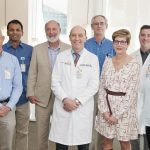Identifying New Treatment Combinations in Lung Cancer
Read moreType: Translational
Facilitate the transition of projects from the laboratory to the clinic. Translational researchers seek to apply basic knowledge of cancer and bring the benefits of the new basic-level understandings to patients more quickly and efficiently. These grants are $600,000, three-year commitments
Benjamin L. Ebert, M.D., Ph.D., Ann Mullally, M.D., William Kaelin, Jr., M.D., David Steensma, M.D.
Gianpietro Dotti, M.D., Cliona Rooney, Ph.D., Caridad Martinez, M.D.
Michael Weber, M.D.
“Precision medicine” aims to develop better treatments by understanding the molecular causes of disease. This is essential in cancer because each type (breast, brain, or blood cancer, for example) represents dozens of different kinds of cancer at the molecular level. And each of these different molecular sub-types requires different treatments.
Based on research of the past twenty years, we understand a great deal about what drives cancers. Many drugs have been devised that specifically target these causes – molecular “smart bombs.” However, the cancer cells rapidly adapt and find escape routes. Drugs that seem to work ultimately fail. We get many hopeful responses but few cures.
Our research seeks to identify and block these escape routes. We look at the molecular changes inside cancer cells after drugs are applied, and we then use other drugs to “slam the door” so the cancer cannot escape treatment. Our approach is already proving successful: We are testing one of these combinations in people to treat Mantle Cell Lymphoma. We propose to look at similar cancers that might benefit from this approach. We also want to better understand ways that cancer cells might escape from our combination treatments. Our goal is to improve responses to therapy and turn temporary responses into real cures.
David Tuveson, M.D., Ph.D.
Pancreatic cancer is one of the deadliest cancers, largely because most therapies are poorly active in patients or are too toxic when administered. Indeed, pancreatic cancer patients become ill very quickly, and cannot withstand the side effects of chemotherapy that patients with other types of cancer can tolerate. Therefore, we need to identify new therapies that kill pancreatic cancer cells effectively and are well tolerated by patients. To accomplish this goal, we have developed a new model system from pancreatic tumors, called organoids. Organoids are 3D cultures grown in an extracellular material rich matrix, called Matrigel, and can faithfully mimic the patient’s tumor, from which it was derived. Organoids can be used to sequence for mutations in the cancer cells and to test for therapies that could kill the cells. Using organoids, we have identified a number of compounds that can surprisingly kill the different cell types present in pancreatic tumors, including several drugs that are given to millions of people daily and are well tolerated but not previously considered to be cancer medicines. Importantly, we also find that certain combinations of these new drugs can shrink human pancreatic tumors engrafted in mice. Here, we propose to extend these exciting preliminary findings to a broader collection of drugs and a larger collection of organoids, and develop the most promising candidates as new strategies for an early phase clinical trial. Our goal is to test at least one novel combination of non-traditional drugs in pancreatic cancer patients within three years.
Adam Murphy, M.D.
Funded by the Stuart Scott Memorial Cancer Research Fund
PSA is a blood test used to check men for harmful prostate cancer (PCa). A man with high levels
of PSA may have harmful PCa, but if we catch it early, it is almost 100% curable. Men with high
PSA may also have harmless PCa or they may not have cancer at all. To diagnose harmful PCa,
doctors take biopsies of the prostate using painful needles. Fortunately, most of the men end up
having large prostates or harmless forms of PCa. This causes many men to suffer through the
biopsy and then worry about potentially having a harmful cancer. Some men with harmless PCa
will have surgery or radiation from fear, but can have bad side effects.
Prostate Health Index (PHI) is an improved version of PSA that better predicts which men have
harmful, PCa. Doctors use PHI to help men avoid prostate biopsies. Unfortunately, PHI was
never tested for accuracy in African American men (AAM). AAM have the highest chance of
dying from harmful PCa. We need to prove that the test works in AAM like it does in White
men. We will compare how well the test works for predicting harmful PCa in 300 African
American men in comparison to 100 White men that are having a prostate biopsy. If PHI works,
we will be able to detect harmful PCa earlier for African American men. This test will reduce
their chances of dying from the disease.
Leonid Metelitsa, M.D., Ph.D.
Funded by the Buster and Kristen Posey Fund
with Recognition to Dick Vitale
In this project, we aim to develop a safe and effective treatment for a childhood cancer called neuroblastoma. Recently, there has been some success harnessing the human immune system to fight cancer. We have developed an immune-based strategy to target one specific cancer-promoting gene that is known to cause an aggressive form of neuroblastoma. This gene is present in about half of all cases with poor disease outcomes in our patient population. We developed a new cancer vaccine for this gene that causes immune cells in the body to fight cancer cells directly. A mouse version of this vaccine proved safe and potent in mice, so we think we can use the same strategy to create a clinical-grade vaccine that will be safe and effective in humans, too. In this study, we first will test each part of this vaccine separately and then will re-assemble them in a very clean laboratory room. Indeed, this vaccine will be produced under such strict conditions that it will be ready for clinical testing in children with neuroblastoma after this grant is completed. Because we are targeting a gene that is expressed on cancer cells but not on cells of healthy tissues, our vaccine is unlikely to be as toxic as others treatments that are available now in the clinic. This vaccine is easy to deliver, as it can be swallowed and so does not involve a shot, making it easier for pediatric patients.
Corinne M. Linardic, M.D., Ph.D.
Funded by the 2015 V Foundation Wine Celebration
Rhabdomyosarcoma is a connective tissue cancer with features of skeletal muscle, and the most common soft tissue cancer of childhood and adolescence. While most children with the embryonal variant of rhabdomyosarcoma are cured, there is a sub-group of children with high-risk features, making their chance of survival less than one in three. One hypothesis underlying these high-risk features is that there are rhabdomyosarcoma stem cells that can persist in the body despite current standard therapy. A goal of our research laboratory is to identify the cellular pathways that contribute to this persistence of rhabdomyosarcoma stem cells. Over the past several years we have observed that some cellular pathways active during normal skeletal muscle development have been hijacked by embryonal rhabdomyosarcoma cells. We even think that these development pathways communicate with one another to support and reinforce rhabdomyosarcoma stem cells. Our aim in this project is to understand how these cellular pathways communicate with one another, whether they can be inhibited by gene manipulations or pharmacologic agents, then test combinations of these treatments in rhabdomyosarcoma cells in culture and in laboratory mice. We hope to someday translate these findings to clinical trials, opening the door to new treatments for children with this disease.
Ann Leen, Ph.D
Our goal is to develop a potent therapy for pancreas cancer – an incurable disease that is resistant to traditional cancer treatments. Challenges involved in treating this disease include: i) a barrier that surrounds the cancer cells (“tumor stroma”) and limits drug access, ii) diversity among cancer cells, making it hard to find a single means of killing all cells, and iii) the harsh cancer milieu, which prevents immune cells from working. Thus, new therapies to beat these barriers are vital and T cell therapy may meet this need. We plan to collect immune cells, called T cells, from patients and in the laboratory we will train them to find and kill tumor cells that display “tumor associated antigens – TAAs” on their surface. We plan to use cells that have been trained to look for tumor cells expressing 5 different TAAs in a clinical trial where we will gauge if this therapy is both safe and active in patients. Next, to ensure that our cells retain their ability to kill in the tumor milieu we will equip them with a special switch that allows them to convert bad signals into ones that are good for our T cells. Hence, we will turn an “off” switch into an “on”. By using this tactic, we hope to boost the activity of our therapy.
Christopher Flowers, M.D., MS
Diffuse large B-cell lymphoma (DLBCL) is the most common blood cancer. Most patients with DLBCL are cured with treatment. People are more likely to die if they do not get standard treatment or if they have a worse type of DLBCL. DLBCL can be divided into two major types: GCB disease and ABC disease. 90% of GCB patients and 44% of ABC patients are alive 3 years after standard treatment. We think that the same number of ABC and GCB DLBCLs occur. We do not know if there are racial differences. We saw that African-American patients get DLBCL at a younger age than white patients and more often die. We also saw that in the past black patients did not get standard treatment as often. We want to understand why African-Americans have worse survival. We will examine differences in the numbers of ABC DLBCLs in the population of the state of Georgia. We will collect DNA to examine the genes linked to ABC DLBCL. This will be the first statewide study to collect data on the genetics of DLBCL, the treatment that patients received, and their survival. From this, we plan to identify which factors are most important to target to eliminate racial disparities in cancer survival.














